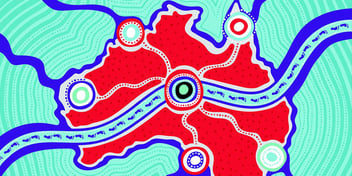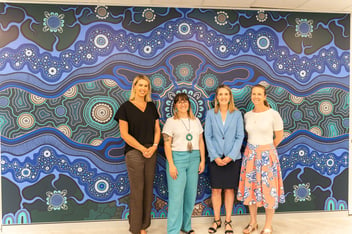How can the water industry better collaborate with Indigenous Australians?
Millennia before the arrival of Europeans, and for thousands of generations, Indigenous Australians have called the driest inhabited continent on Earth home.
How can the water industry improve its collaboration with Indigenous communities to move towards a more equitable water resource sector?
Historical precedent
Australia’s past treatment of Indigenous people is not a fair one. For much of this country’s history, Indigenous Australians weren’t counted in the census, or categorised as people – they fell under ‘flora and fauna’ until 1962.
“Before the late 1960s, our land and our water were being taken, so by the time we were legally classified as humans, much of the water and land was already gone,” said Brad Moggridge, a Kamilaroi man and hydrogeologist studying the interplay between traditional Indigenous ecological knowledge and western science.
Since then, a few initiatives have worked to rectify this. There was the Native Title Act in the early 1990s, and later the 2004 National Water Initiative (NWI), which was the first major piece of natural resources policy to recognise Indigenous Australian’s interests in water resources.
Under the NWI, government agencies must consider the water needs of Indigenous Australians when planning projects. However, in the 12 years since, Federal and State Governments have grappled with how to recognise and honour those interests.
Implementing policy provisions for Indigenous people have been slow to take shape, especially in water-strapped areas where resources are already fully or over-allocated.
“This is a complicated issue – especially in terms of entitlements and water access – because water management has been operating in Australia for decades,” said Lachlan Sutherland, Aboriginal partnerships coordinator for water policy with South Australia’s Department for Environment, Water and Resources.
“There are a lot of legacy systems in place and established water users. To try and go back and address these issues with Aboriginal water policy is a politically challenging thing to do.”
Close the gap
To complicate matters more, water and land rights are currently separated, something that Moggridge said “Indigenous people didn’t understand, because without water the land is nothing”.
Michael Spencer, CEO of Water Stewardship Australia and chair of the international Alliance for Water Stewardship, said that unless this difference is understood and explored, efforts to involve Indigenous Australians in water resources management and planning would continue to falter.
“More people understand the connection between Indigenous people and country, but by definition the country only exists and comes to life in relation to water. Having land rights is a step forward, but there are limitations on what you can do with the land if there’s no water to go with it,” he said.
To give you an idea of what this looks like, Indigenous people own about 20% of the country’s land, much of it in remote and regional areas. However, their water entitlements add up to less than 0.01% of Australian water resources.
Fuelling this disparity is the fact that although many Indigenous Australian’s have intimate knowledge of this country’s land and water, much of that is hard to quantify.
A 2008 Australian Human Rights Commission report found that Indigenous water rights are not adequately recognised by laws and policy because Indigenous and non-Indigenous perspectives on water management greatly differ.
“It’s hard to validate traditional knowledge; in a science journal, how can I reference my great-great-great-great-great grandfather who showed his descendants and so on about how to protect and care for our waterholes?” Moggridge said.
“It’s about seizing opportunities for Indigenous people to show they do have a right to water, and they have knowledge about its management that can add to and improve Western styles of water management.”
Efforts to reconcile these differences are relatively young, but quickly gaining momentum. For example, as part of its 2016-17 state water plan, the Victoria Government allocated $9.7 million towards establishing a bespoke Aboriginal Water Unit.
It’s a step in the right direction, but high-level policy reform like this only works when coupled with grassroots community engagement, said Sutherland.
“There’s absolutely a policy gap in Australia. There’s still a lot of work to do in that arena, but it’s going to require not just high-level directives, but individual organisations working within communities to make change as well.”
A recent study by researchers at Griffith University found that methods for engaging with Indigenous stakeholders were cited as the most required improvement for water planners.
The appetite for collaboration is there, but Moggridge cautioned against thinking that all it takes is good intentions.
Nadine Riethmuller, manager for water planning for remote operations for Power and Water Corporation in the Northern Territory, said that while Indigenous engagement is not a quick endeavour, from her experience it’s a worthwhile one.
“It depends on long-term, trusted relationships between people in those communities and utilities,” said Riethmuller, who is also vice-president of the Australian Water Association’s Northern Territory branch.
“In many Indigenous communities, there are local authority systems or key knowledge holders that need to be engaged with first, so it’s good to know the appropriate forums to tap into and go from there.”
Hands-on engagement with communities also provides valuable insight that “you wouldn’t be able to tell just from sitting at a desk and looking at data”, Riethmuller added.
“Learning how those communities are – or aren’t – using water and how they relate to their water resources has led to improvements like reduced water loss and better environmental outcomes. We’ve even found new sources for water-stressed communities simply by asking them for help.”
Critical mass
In addition to recognition of cultural significance and ownership of water, many nations want greater involvement in the commercial aspects of water resources management.
“Water has two dimensions: one is the recognition of cultural sites and cultural issues in relation to water,” said Spencer.
“The other – and of increasing importance – is the economic benefits of access to water.”
Common requests are environmental monitoring oversight, water industry training and employment programs, advice for navigating licencing systems, participation in water markets, and help building the capabilities of Aboriginal communities and organisations to take a more active role in all of the above.
“People have a strong connection to country and to their communities, and they want opportunities to develop both,” Riethmuller said.
“Everyone wants jobs, First Nations want their organisations resourced and involved in water planning, and they want more authority in decision-making,” Sutherland said.
“Rather than using government organisations or NGOs, we try to channel those resources through Indigenous-led organisations so they can take more of a leadership role.”
An example of this approach comes from the Ngarrindjeri nation in south-east Australia. The nation won the prestigious Australian Riverprize in 2015 for its innovative approach to sustainable river basin management, in collaboration with the South Australian Government.
Sutherland said that one clear outcome of joint-nation workshops hosted by his department is that any approach needs to be nation-specific.
That last point speaks to a larger issue about getting more Aboriginal voices into the mix, said Moggridge.
“When you’re only one person speaking out, it can be hard to influence anything,” he said.
“I can only speak for my nation; I can’t talk on behalf of Aboriginal Australia. There needs to be a critical mass of indigenous people active in this space, but it will also require the water industry to step outside its comfort zone.”
First published in Current magazine May 2017.




